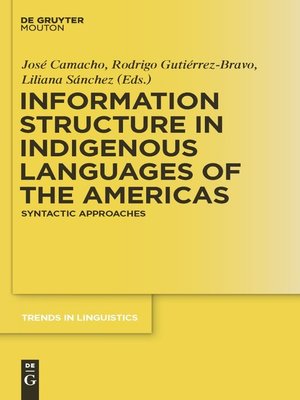Information Structure in Indigenous Languages of the Americas
ebook ∣ Syntactic Approaches · Trends in Linguistics. Studies and Monographs [TiLSM]
By José Camacho

Sign up to save your library
With an OverDrive account, you can save your favorite libraries for at-a-glance information about availability. Find out more about OverDrive accounts.
Find this title in Libby, the library reading app by OverDrive.



Search for a digital library with this title
Title found at these libraries:
| Library Name | Distance |
|---|---|
| Loading... |
The study of the interaction between syntax and information structure has attracted a great deal of attention since the publication of foundational works on this subject such as Enric Vallduví's (1992) The Informational Component and Knud Lambrecht's (1994) Information Structure and Sentence Form. The book inserts itself in this contemporary interest by providing a collection of articles on different aspects of the syntax-pragmatics interface in the indigenous languages of The Americas.
The first chapter provides a brief introduction of the some of the basic descriptive issues addressed in them, and of some of the theoretical tools that have been developed to analyze them. The reader finds articles that focus mostly on empirical issues, while others are mostly oriented to theoretical issues. Diverse theoretical approaches are addressed, including Minimalism, Optimality-theoretic syntax, and Meaning-Text Theory.
The volume includes articles on the following topics: the grammatical means to encode pragmatic notions in Tariana (A. Aikhenvald); the relation between clause structure and information structure in Lushootseed (D. Beck); the split distribution of null subjects in Shipibo (J. Camacho and J. Elías-Ulloa); the syntactic structure of left-peripheral discourse-related functions in Kuikuro (B. Franchetto and M. Santos), an agglutinative and head final language; word order and focus patterns in Yaqui (L. Guerrero and V. Belloro); SVO and topicalization in Yucatec Maya (R. Gutiérrez-Bravo and J. Monforte); the structure of the left-periphery in Karaja (Maia) and the interaction between the wh-words and polarity sensitivity in Southern Quechua (L. Sánchez).







